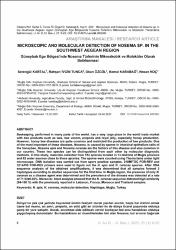| dc.contributor.author | Kartal, Serengül | |
| dc.contributor.author | İvgin Tunca, Rahşan | |
| dc.contributor.author | Özgül, Okan | |
| dc.contributor.author | Karabaǧ, Kemal | |
| dc.contributor.author | Koç, Hasan | |
| dc.date.accessioned | 2021-06-10T10:32:39Z | |
| dc.date.available | 2021-06-10T10:32:39Z | |
| dc.date.issued | 2021 | en_US |
| dc.identifier.citation | Kartal S, Tunca Rİ, Özgül O, Karabağ K, Koç H. 2021. Microscopic and molecular detection of Nosema sp. in
the Southwest Aegean region (Güneybatı Ege Bölgesinde Nosema Türlerinin Mikroskobik ve Moleküler Yöntemlerle
Belirlenmesi). U. Arı D./U. Bee J. 21: 8-20, DOI: 10.31467/uluaricilik.880380 | en_US |
| dc.identifier.issn | 13030248 | |
| dc.identifier.uri | https://doi.org/10.31467/uluaricilik.880380 | |
| dc.identifier.uri | https://hdl.handle.net/20.500.12809/9310 | |
| dc.description.abstract | Beekeeping, performed in many parts of the world, has a very large place in the world trade market with bee products such as wax, bee venom, propolis and royal jelly, especially honey production. However, honey bee diseases are quite common and restricted the production of bee products. One of the most important of these diseases, Nosema, is caused by spores in intestinal epithelium cells of the honeybee. Nosema apis and Nosema ceranae are the factors of this disease and also common in our country. These two species can be distinguished from each other by molecular diagnostic methods. In this study, materials collected from 152 apiaries located in 13 districts of Mugla province and 62 water sources close to these apiaries. The spores were counted using Thoma lame under light microscope. DNA isolation was carried out from spore positive samples. 218MITOC FOR-REV and 321APIS FOR-REV primers were used to figure out the N. apis and N. ceranae species. After DNA sequence analysis of the obtained amplifications, it was determined that all samples formed 3 haplotypes according to studied sequences for the first time. In Mugla region, the presence of only N. ceranae as a disease agent was determined and the prevalence of the disease was detected at a rate of 71.53±6.02%. Moreover, blast analysis showed that the N. ceranae sequence detected high similarity (94-100 %) with the previously reported in Lebanon, France, Morocco and Thailand samples. | en_US |
| dc.description.sponsorship | Funding text 1
Financial Aid: The study was supported by Muğla Sıtkı Koçman University Scientific Research Projects Coordinator with project number 17/010.
Funding text 2
The study was supported by Mugla Sitki Ko?man University Scientific Research Projects Coordinator with project number 17/010. | en_US |
| dc.item-language.iso | eng | en_US |
| dc.publisher | Bursa Uludag University | en_US |
| dc.relation.isversionof | 10.31467/uluaricilik.880380 | en_US |
| dc.item-rights | info:eu-repo/semantics/openAccess | en_US |
| dc.subject | N. apis | en_US |
| dc.subject | N. ceranae moleküler tespit | en_US |
| dc.subject | Haplotip | en_US |
| dc.subject | Muğla | en_US |
| dc.subject | Türkiye | en_US |
| dc.title | MICROSCOPIC AND MOLECULAR DETECTION OF NOSEMA SP. IN THE SOUTHWEST AEGEAN REGION | en_US |
| dc.item-title.alternative | Güneybatı Ege Bölgesi’nde Nosema Türlerinin Mikroskobik ve Moleküler Olarak Belirlenmesi | en_US |
| dc.item-type | article | en_US |
| dc.contributor.department | MÜ, Ula Ali Koçman Meslek Yüksekokulu, Bitkisel Ve Hayvansal Üretim Bölümü | en_US |
| dc.contributor.authorID | 0000-0003-0745-6732 | en_US |
| dc.contributor.institutionauthor | İvgin Tunca, Rahşan | |
| dc.contributor.institutionauthor | Özgül, Okan | |
| dc.contributor.institutionauthor | Kartal, Serengül | |
| dc.identifier.volume | 21 | en_US |
| dc.identifier.issue | 1 | en_US |
| dc.identifier.startpage | 8 | en_US |
| dc.identifier.endpage | 20 | en_US |
| dc.relation.journal | Uludağ Arıcılık Dergisi | en_US |
| dc.relation.publicationcategory | Makale - Uluslararası Hakemli Dergi - Kurum Öğretim Elemanı | en_US |


















